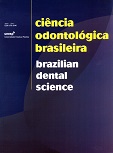Ação do fluor fosfato acidulado 1.23% sobre a resina composta: microdureza
DOI:
https://doi.org/10.14295/bds.2006.v9i4.453Abstract
O objetivo deste trabalho foi o de verificara influência da opacidade de cor, e aplicação tópica do FFA 1.23% na microdureza da resina composta quando utilizado aparelhos fotopolimerizadores de luz halogena e LED azul. A resina composta Esthet-X (Dentisply), nas cores A2 e A2-O, foi inserida em uma matriz de aço-inoxidável em cavidades de 5mm de diâmetro e 2mm de profundidade e fotopolimerizada por aparelhos; de luz halogena, XL 3000 (3M) ou de LED azul, Optilight LD II (Gnatus), por 40s. Formaram-se 4 grupos com quinze amostras cada, sendo analisadas as superfícies das amostras. Estas foram armazenadas em água destilada, por 24h e posteriormente embutidas em resina acrílica ativada quimicamente. Realizou-se a leitura da microdureza inicial em Microdurômetro Digital Vickers, utilizando 50g de carga por 30s de permanência. A seguir, foi aplicado o FFA 1.23% por 48 min e uma segunda leitura da microdureza foi realizada. Os dados foram submetidos ao teste estatístico de ANOVA e Tukey (5%). Os resultados demonstraram que a aplicação tópica do FFA 1.23% promoveu uma redução signifi cativa nos valores médios de microdureza da resina A2 e A2-O. O uso das fontes de luz halógena e LED e o emprego de diferentes opacidades não promoveram diferença signifi cante na microdureza superfi cial na resina. Concluiu-se que a variação da opacidade da resina e o emprego de diferentes fontes de luz (halogena/LED) não infl uenciaram a microdureza superfi cial, porém a utilização tópica do FFA 1.23% alterou o grau de microdureza da resina.
Downloads
Downloads
Published
How to Cite
Issue
Section
License
Brazilian Dental Science uses the Creative Commons (CC-BY 4.0) license, thus preserving the integrity of articles in an open access environment. The journal allows the author to retain publishing rights without restrictions.
=================




























